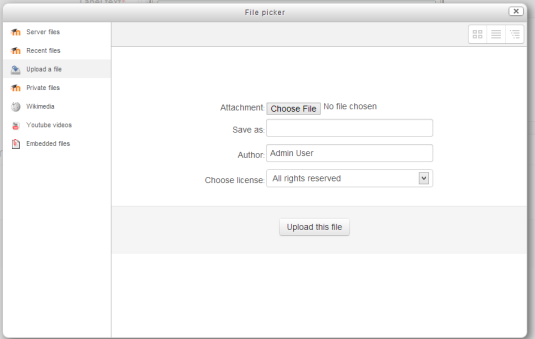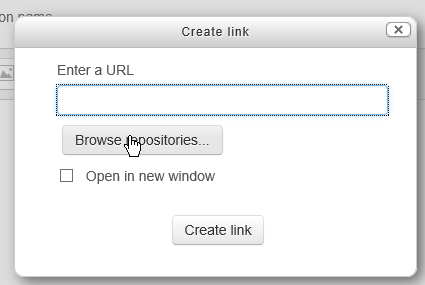Video
- Video is a very powerful tool to use in a Moodle course, allowing students, for example to catch up on lectures they missed, learn from a "how to" screencast, or improve their language skills by watching native speakers interact.
- For a discussion on the best type of video file for Moodle, see here
- For a discussion of the best programs for creating screencasts, see here
Where to host the videos
- Whenever possible, it is preferable to upload your videos to Moodle, storing them on your own server as you retain ultimate control. However, when server space or upload limits are restricted, it is convenient to upload videos to an online site like youtube [1] or Vimeo[2]. They can easily be embedded inside Moodle from such sites and privacy can still be maintained if you choose their private video sharing option.
Ways of displaying video
Linking to a video online elsewhere
- If your video is hosted elsewhere online (such as youtube) you can simply link to the relevant page by choosing Add a resource>URL and pasting in the relevant link.
- For more information, see URL
- Note that, in an establishment where certain video sharing sites might be banned, your students might not be able to access your video through Moodle.
Uploading a video for students to download
- Choose this option if you wish to upload your video to Moodle and give users the option to download it to their own computers.
- Choose Add a resource>File
- For more information, see File
- Note that the way the video will display depends on the software the user has on their own computer. This could mean that some students might be unable to view your video. (See this discussion here)
Embedding a video in its own player
- Moodle has an inbuilt video player called Flowplayer. If multimedia filters are enabled by the administrator, videos embedded into the text editor will play inline in Flowplayer.
- Anywhere that Moodle's TinyMCE text editor is available, it is possible to embed a video, for example in a label or a page, a course topic summary, a quiz description or a lesson.
Using the Moodle media icon
- With your editing turned on, click into the HTML editor where you wish to embed your video.
- Click the Moodle media icon as in the following screenshot:
- Click Find or upload a sound,video or applet
- The file picker will appear:
- Either click Upload a file to upload from your computer or choose the appropriate repository from which you wish to bring in your video. (What you see will depend on what the Moodle admin has enabled)
- Note: To search for and embed a video from youtube, see here
- Change the save as/author/license settings if desired and click upload this file or select this file
- Your video will appear in a preview player. Click Insert at the bottom
- Don't panic! You will now only get a blue text link of your video:
- When you click save changes to return to the main course page, your video will display:
Using a hyperlink
(Note - this method has no advantage over using the media icon, but was popular in older versions of Moodle)
- With your editing turned on, click into the HTML editor where you wish to embed your video.
- Type some blank spaces and select them.
- Click the hyperlink icon as in the following screenshot.(The icon will only be clickable if you have selected text or spaces)
- Click the icon to the right of the link URL box:
- This takes you to the file picker. Follow the instructions for uploading/selecting your video as for using the Moodle media icon.
- When your video is chosen, it will appear in the link URL box as below. Click Insert:
- Don't panic! You will now only get a blue line in the HTML editor:
- When you click save changes to return to the main course page, your video will display.
Using embed code to display external videos
- Go to your chosen video sharing site and find the embed code of the video you wish to display. Copy this code.
- With your editing turned on, click into the HTML editor where you wish to embed your video.
- Click the HTML code icon as in the following screenshot:
- Paste your embed code into the box:
- Scroll down and click "update".
- Your video will be previewed in the HTML editor. Click save changes for it to display on the page
FAQ
Should I put my video into a label or a page?
While the embedding process is the same, adding a video to a label will mean it displays as soon as the user clicks on that course page. This can be beneficial if the video is, for example, an introduction to the course or an integral part of the whole course. However, if there are several videos in labels, they can slow the loading of the course down, especially if the videos are coming from an external site. Adding a video to a page in Moodle means that the user has to click a text link to reach the video, but it doesn't clutter up the main course page and it is a better choice if th course contains a large number of videos.
My embedded video is too big/small. How can I change its display size?
- With the editing turned on, cick the edit (hand/pen) icon to get into the HMTL editor where you embedded your video.
- Click the HTML code icon:
- You will see the code of your video there.
- For videos you uploaded yourself... Find the file extension (such as flv or wmv) and just after the file extension and before the ", type in ?d=400x300(for example) where 400 and 300 are the width and height in pixels of the display size you wish your video to be:
- For external videos you embedded with embed code...Change the height and width numbers to the size in pixels you wish your video to be:
- Click Update and then, on the next screen, click Save changes. Your video will now display in a different size.
Why won't my swf video play?
The .swf format carries with it some security issues and so the filter that allows it to display is disabled by default. For you to be able to add .swf videos, your administrator needs to enable the filter in Multimedia plugins, then to go to Site Administration>Security>Site policies and check the "enable trusted content" box. They then need to go to Site Administration>Users>Permissions>Define roles and allow Trust Submitted content moodle/site:trustcontent for your role.










